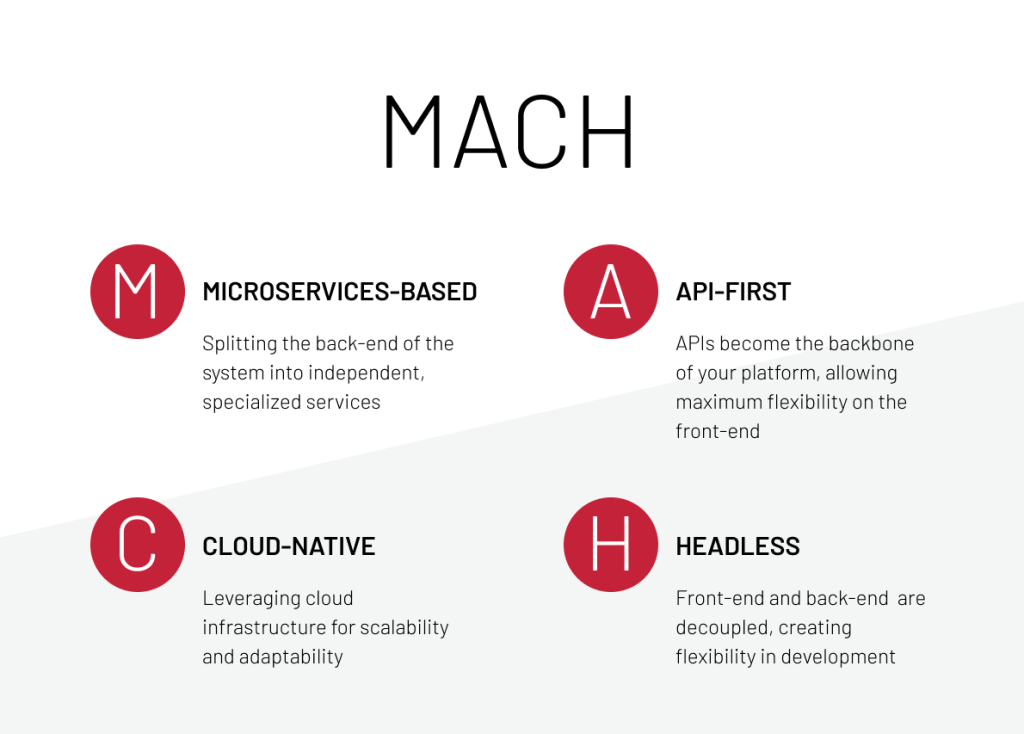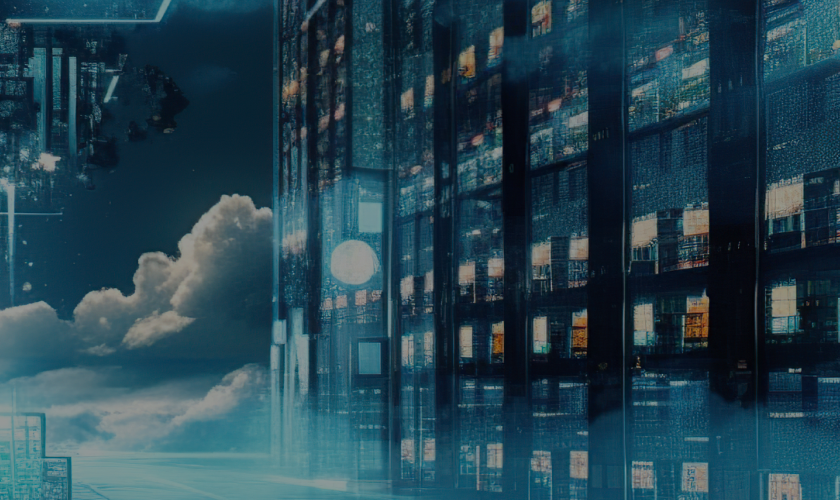MACH Architecture: Principles and Benefits

In the wild world of ecommerce, businesses are always searching for their next big move, whether it’s shifting to the cloud or unlocking the power of microservices. Every path has its set of challenges and investments, some more mind-bending than others. But what if we threw convention out the window and merged the boldest moves into one force? Then, we end up with the MACH approach.
MACH, an abbreviation for Microservices-based, API-first, Cloud-native, and Headless, aligns nicely with the major IT trends, offering composable systems. The MACH Alliance’s 2024 Global Survey, found that 91% of IT leaders consider MACH as important to their organization’s success in the next five years, while the majority, at 85%, already see returns on MACH approach investments.
This article will explain what MACH architecture is, covering its foundational components, and how Expert Soft applies MACH architecture basic principles in high-demand environments. We’ll also look at the strategic advantages MACH brings to established ecommerce platforms aiming to scale without limits. Let’s get to it.
Quick Tips for Busy People
As MACH architecture evolves, it changes the way organizations can build agile and scalable digital platforms. Here’s a snapshot of why MACH is the go-to solution for enterprises.
- MACH architecture principles: MACH combines the principles of Microservices-based, API-first, Cloud-native, and Headless, allowing the creation of scalable, agile platforms that adapt to changing demands.
- Key benefits: scalability, flexibility, security, and improved customer experience make MACH a game-changer.
- Challenges: MACH adoption requires complex implementation, integration management, high initial costs, and specialized tech expertise.
- Future impact: MACH adoption is rapidly growing, with industries like retail leading the way and global investment increasing.
Now let’s go a bit deeper into the MACH architecture.
MACH Principles
We start with a look at what exactly MACH architecture is. As already mentioned, the MACH architecture model, defined as Microservices-based, API-first, Cloud-native, and Headless, is a modern framework enabling organizations to build systems that are fast, flexible, and capable of delivering a seamless customer experience (CX). This MACH architecture definition highlights its composable nature, allowing enterprises to shift away from rigid, monolithic platforms toward a scalable model.
In fact, Gartner predicts that by 2027, at least 60% of all new B2C and B2B digital commerce cloud-based solutions will follow the principles of MACH architecture.
Below, we break down these MACH principles to see how they help platforms succeed in the demands of modern commerce.

Microservices-based
Microservices architecture is about splitting a system into independent, specialized services focused on distinct functionality. This approach delivered significant benefits for a leading credit rating agency, whose financial insights platform was enhanced by Expert Soft.
In this project, microservices architecture advantages were fully realized, enhancing the client’s platform. Independent scalability allowed each service to meet specific demands, optimizing performance and resource use. System resilience improved as autonomous services minimized the impact of individual failures, ensuring stability across the ecosystem. Efficiency also surged, with seamless updates to individual services, accelerating development speed and reducing operational costs.
API-first
An API-first approach means APIs become the backbone of your platform, allowing maximum flexibility on the front-end development without impacting the back-end. This supports modular updates, real-time integrations, and scaling flexibility — all crucial features for any ecommerce system where change is a constant.
Cloud-native
Cloud-native applications leverage cloud infrastructure for scalability and adaptability, making them suitable for high-demand environments. Expert Soft delivers on this approach through technology expertise in SAP Commerce Cloud, a cloud-native SaaS solution. The platform allows us to build high-load applications that would dynamically respond to real-time demand. It assures a seamless, always-available experience for end-users and optimizes operational costs of the businesses out there.
Headless
In headless commerce architecture front-end and back-end system parts are decoupled, creating flexibility in interface development and content delivery to users. For example, one of the world’s top cosmetics brands was suffering from poor performance and a lack of scalability using the traditional architecture, which impacted both user experience and growth.
Expert Soft provided a solution by transitioning the brand to headless, which allows for faster site performance and improved responsiveness. The change enabled the organization to scale easily and handle high-traffic demands without a hitch.

All these principles make the MACH architecture, first introduced by the MACH Alliance, an attractive option for enterprises to build composable ecommerce platforms.
MACH Alliance
Founded in 2020, the MACH Alliance is a global consortium with a mission to champion open, flexible enterprise architectures in an ever-evolving digital landscape. Established by industry leaders, the alliance educates and supports companies transitioning from monolithic systems to composable frameworks built on MACH principles. So, what are the key improvements?
Monolith vs. MACH
While monolithic systems are traditionally reliable, the centralized structure tends to become restrictive, hindering scalability, agile updates, and cost-efficiency.
In contrast, MACH architecture is designed with flexibility and resilience in mind. It allows independent scaling of each component and thus independently updates with rapid, low-risk deployments that ensure infrastructure costs align with actual demand. Below, we present a comparative look at these architectures across essential operational dimensions.
| Feature | Monolith | MACH |
| Scalability | Limited by a central, rigid structure | Scales independently with each modular component |
| Flexibility | Rigid; updates affect the entire system | Flexible; updates apply to individual components |
| Deployment | Slow, with a higher risk of downtime | Fast, safe deployments for each component |
| Cost efficiency | Higher costs due to fixed infrastructure | Higher initial investment but long-term cost savings through scalable, on-demand resources |
| Technology stack | Limited to a single technology stack; difficult to integrate new tools | Supports multiple tools and technologies, enabling a best-of-breed approach |
| Maintenance | Higher maintenance effort; tightly coupled components make updates complex | Lower maintenance; modular design simplifies updates and troubleshooting |
| Time to market | Slower due to lengthy deployment cycles | Faster; independent updates reduce time to launch new features |
Having compared MACH with traditional monolithic systems in the table above, we’ve already highlighted its key advantages. What we need now is to dive deeper into the tangible business value MACH architecture delivers, helping organizations achieve sustained growth and agility.
Business Value of the MACH Approach
Here’s how MACH architecture supports enterprise growth and innovation.
-
Scalability
Thanks to headless and microservices principles, MACH allows independent scaling of individual components depending on demand, saving resources and reducing bottlenecks. Such flexibility ensures that all parts of the platform can scale up during traffic spikes without affecting other areas, so the overall performance is optimized.
-
Agility
With its decoupled services, MACH enables rapid updates, quicker feature rollouts, and swift responses to market changes — all of which are critical in fast-moving digital environments.
-
Resilience
MACH architecture guarantees minimal risks of total system failures, thanks to the independence of all components. Issues in one area remain isolated, maintaining service continuity and enhancing platform reliability, crucial for high-traffic applications.
-
Cost-effectiveness
MACH’s modular approach enables businesses to scale resources up or down as needed, preventing over-provisioning. This, in turn, ensures that infrastructure costs align with real-time demand, ultimately optimizing resource use and reducing expenses.
-
Future-readiness
Made for a rapidly evolving tech landscape, MACH's modularity makes it easier to adopt new technologies and keep up with the changing needs of customers. This future-proofing guarantees that businesses will remain competitive as the digital and commerce worlds continue their evolution.
In fact, studies reveal that 83% of companies that have implemented MACH see clear evidence of return on investment (ROI). Organizations that regularly update their UI/UX see the highest ROI results (60%), reinforcing MACH’s value in delivering agility and a responsive user experience.
Real-world example
Let’s study a case that demonstrates how the MACH modular approach has empowered PUMA, the world-renowned global sports brand, to streamline its operations.
When the COVID-19 pandemic forced shoppers online, Puma was posed with a big challenge: how to improve the ecommerce search for their multilingual offerings to avoid frustrating “no results” for customers.
PUMA responded with a MACH-based strategy, focusing on composable technology to drive targeted improvements in user experience and empower local teams to respond quickly to shifting market conditions.
As a MACH Ambassador, PUMA integrated Klevu’s AI-driven search and merchandising across 10 regional websites to enhance search relevance and drive conversions. Additional MACH tools, such as Sanity for content management and Emarsys for email automation, further streamlined their digital stack.
By adopting MACH architecture, PUMA unleashed flexible ecommerce experiences and faster time-to-market in different regions, increasing the search-led conversion by 52%.
MACH Architecture Challenges
While MACH brings significant benefits, adopting MACH architecture presents several challenges for organizations. Here are some key considerations based on data.
1. Initial investment concerns
32% of companies worry about the trade-off between initial investment and long-term benefits. While transitioning to MACH does require a significant upfront investment, its scalability and efficiency lead to cost savings over time. The challenge is balancing short-term costs with long-term growth potential.
2. Resistance to change
33% of IT teams and 30% of end-users resist shifting to MACH architecture. This resistance stems from comfort with existing web systems and fear of disruption. Successful adoption involves clear communication, training, and support to help teams embrace change, ultimately leading to greater flexibility and agility.
3. Vendor lock-in
29% of companies struggle with reliance on current vendors, which can hinder MACH adoption. Businesses fear switching due to vendor dependencies. By rethinking vendor relationships and ensuring MACH architecture integration, organizations can gain flexibility and access best-in-class composable products.
4. Integration and skill gaps
MACH adoption requires strong oversight and specialized expertise in microservices, headless, and cloud-native solutions. Businesses may struggle with these integration challenges and skill gaps. An experienced development partner with relevant expertise in approaches and technologies, e.g. Expert Soft, can ensure smooth implementation and success.
Overcoming the challenges with solid strategic, architectural, and development planning and management pay in the long run, increasing web system efficiency.
How to Assess MACH Effectiveness
To evaluate whether MACH architecture is effective for your platform, consider these six key questions:
- Modularity: can individual services be replaced or updated without disrupting the entire system?
- Scalability: does the platform smoothly handle increased traffic and scale easily as demands grow?
- Developer productivity: has the MACH approach improved developer efficiency, reducing the time needed for updates and fixes?
- Time-to-market: are new features or updates being launched faster, thanks to MACH’s flexibility?
- Operational efficiency: does the platform allow teams to optimize and adjust resource use as demand fluctuates?
- User experience: has MACH contributed to a more reliable, personalized, and seamless customer experience across channels?
Answering “yes” to these questions suggests that your MACH architecture is effectively driving agility and scalability across your platform.
Is MACH Architecture a Future Trend?
Recent studies highlight that MACH architecture isn’t just a passing trend but a growing movement with strong future potential. Here’s why:
- MACH adoption is steadily growing, especially among companies with legacy IT systems: 94% have increased MACH investment.
- 90% have expanded MACH-based infrastructure.
- Adoption is particularly high in customer-driven and agile companies (94% and 91%, respectively) and is strongest in the UK (93%) and the U.S. (46%).
- Key sectors like retail (95%) and professional services (89%) are leading MACH adoption, driven by the need for flexibility, enhanced customer experience, and innovation.
This data suggests that MACH architecture is positioned to become a foundational architecture for businesses seeking scalability, agility, and digital resilience.
Integrating AI into MACH brings a whole new level of adaptability and insight. With AI, a new iteration of MACH doesn’t just support digital platforms — it makes them smarter and more responsive.
Using AI-powered MACH, ecommerce companies get a jump start in personalizing customer experiences (CX) in real time, predicting inventory needs, and automating operations — all that makes their products more efficient.
In essence, the MACH approach paves the way for a more adaptable, future-ready digital commerce platform. If you’re considering transforming your system with MACH, Expert Soft services can help tailor these principles to your unique needs. Reach out to explore how we can make your vision a reality.

Andreas Kozachenko is the Head of Technology Strategy and Solutions at Expert Soft, a global ecommerce software delivery company, providing strategic guidance for large-scale web projects. Andreas has 10+ years of experience with headless and MACH architectures across wholesale, retail, health care and fintech. Andreas's technical initiatives have helped Fortune 500 corporations secure and enhance their ecommerce presence.
New articles

See more

See more

See more

See more

See more
